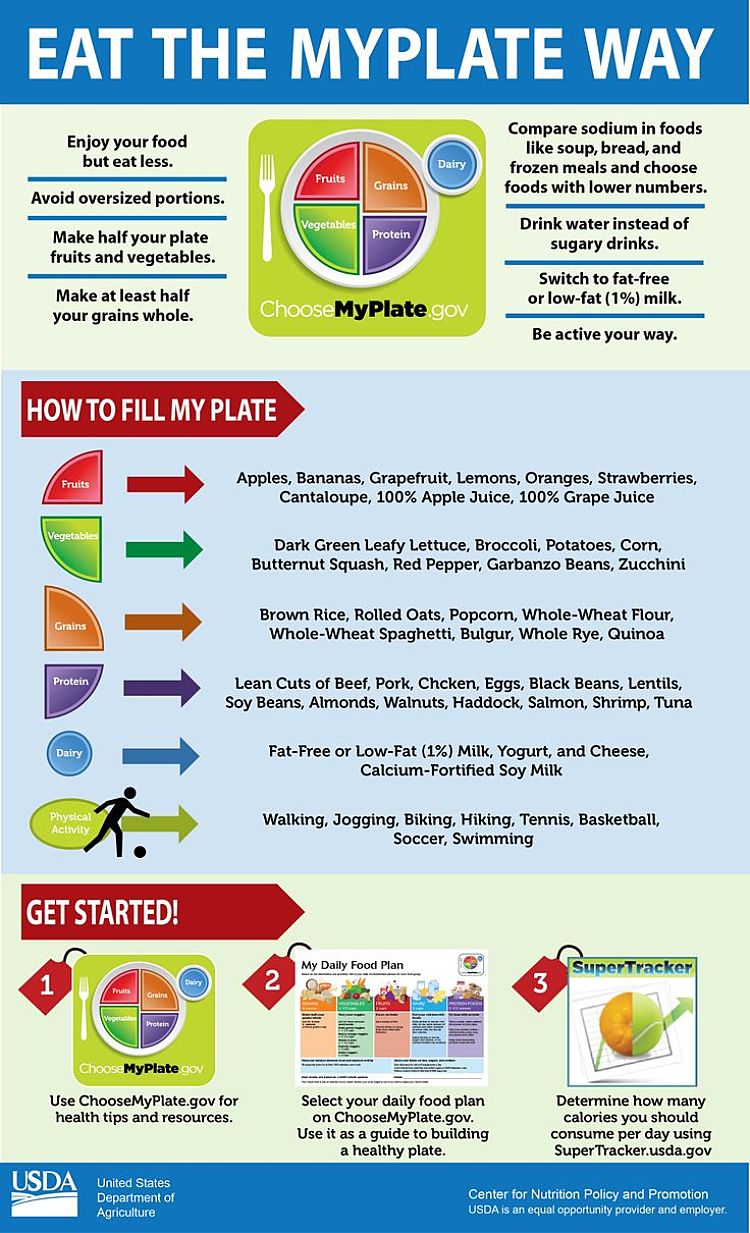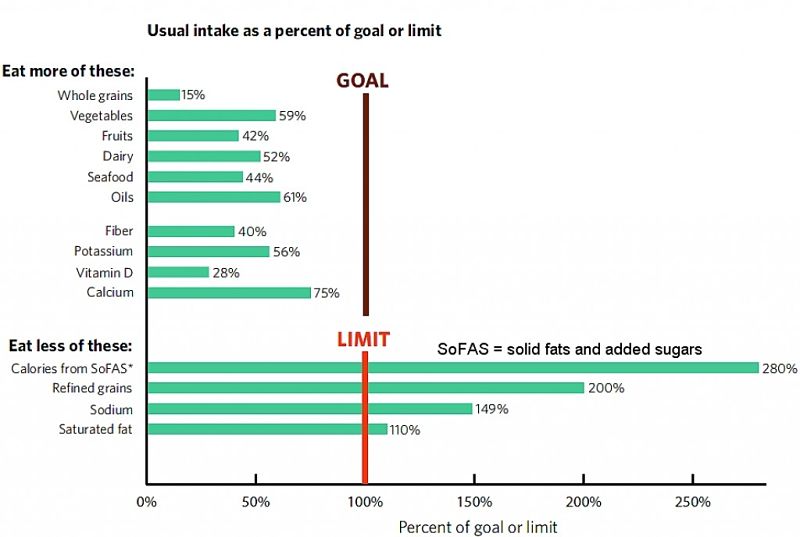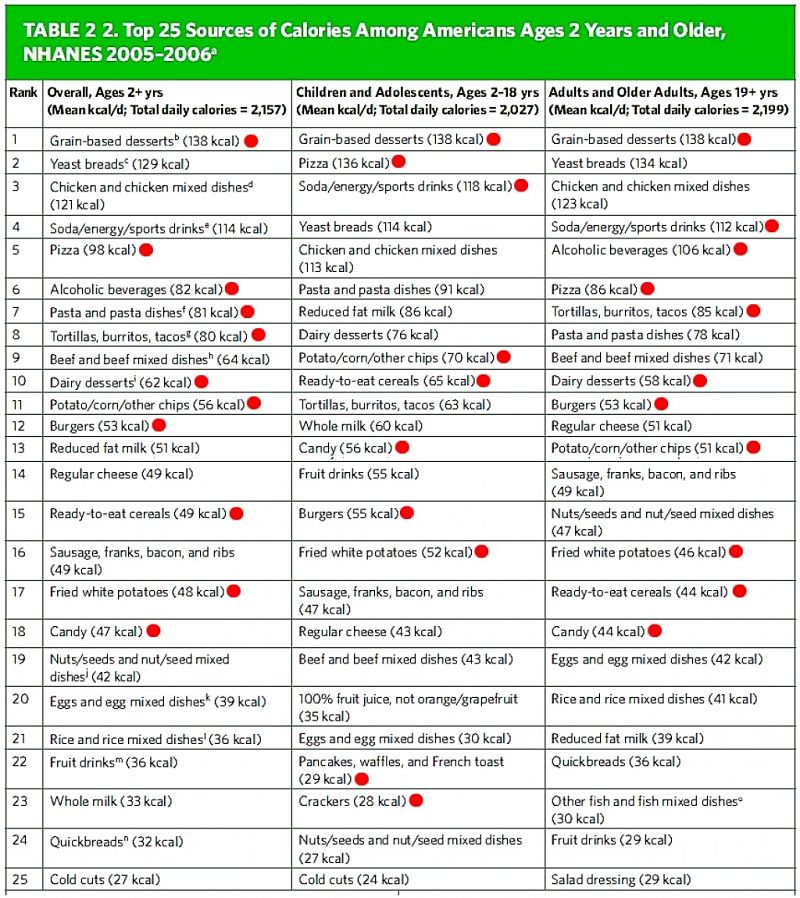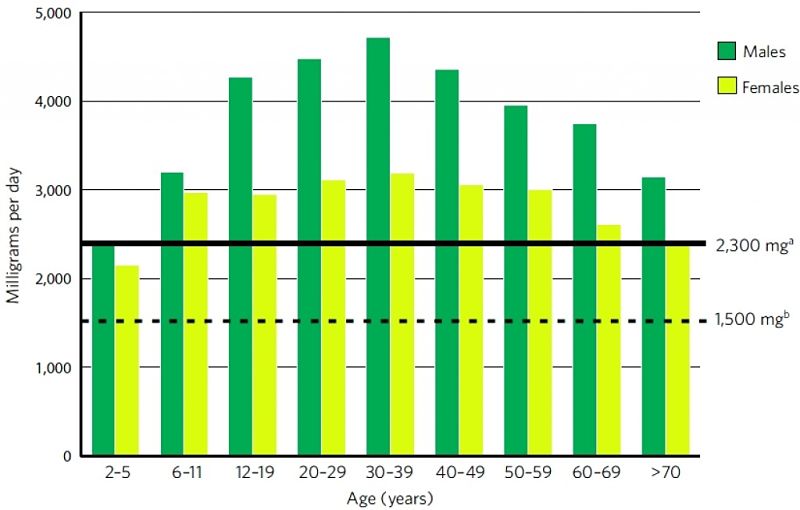Eat Less, Eat Smaller Portions, Eat Nutrient-Dense Foods - USDA Dietary Advice
Nutrition guidelines from the USDA have recently involved several themes ( Dietary Guidelines for Americans ), but can this advice work in reducing obesity, which grows and grows.
The major messages are:
- EAT LESS!
- Reduce Portion Sizes
- Increase Vegetable and Fruit Intake and use these foods as substitutes
- Consume at least half of all grains as whole grains by substituting refined grains (i.e. junk foods) with whole grains.
- Reduce SALT intake to prescribed levels
The Guidelines offer explicit advice about how average diets have to change to address the Obesity epidemic.

New Nutrition Guidelines Are Better
The new nutrition guidelines are much easier to understand, more explicit and more practical.
The guidelines reinforce much of the same advice from previous years: eat less sugar and saturated fats, eat less salt, eat more fruits and vegetables and eat more whole grains, reduce cholesterol.
But now the advice is much more specific and detailed and more focused on reducing 'junk food' intake although this is not explicitly mentioned.
The figure shown below summarizes the major source of calories among Americans. The items which are clearly 'junk' foods have been highlighted in red (added for this article).


There is a strong emphasis on the calorie and nutrient densities of foods.
Calorie Density - Amount of calories provided per unit of food weight. Also known as "energy density...Foods high in water and/or dietary fiber typically have fewer calories per gram and are lower in calorie density, while foods higher in fat are generally higher in calorie density. Calorie density is most useful when considering the eating pattern in its entirety. A healthy eating pattern with low calorie density can include consumption of a small amount of some calorie-dense foods (such as olive oil and nuts). An eating pattern low in calorie density is characterized by a relatively high intake of vegetables, fruit, and dietary fiber and a relatively low intake of total fat, saturated fat, and added sugars.
Nutrient Dense Foods - Nutrient-dense foods and beverages provide vitamins, minerals, and other sub-stances that may have positive health effects, with relatively few calories. The term ',trident dense" indicates the nutrients and other beneficial sub-stances in a food have not been -diluted" by the addition of calories from added solid fats, added sugars, or added refined starches, or by the solid fats naturally present in the food. Nutrient-dense foods and beverages are lean or low in solid fats, and minimize or exclude added solid fats, sugars, starches, and sodium. Ideally, they also are in forms that retain naturally occurring components, such as dietary fiber. All vegetables, fruits, whole grains, seafood, eggs, beans and peas, unsalted nuts and seeds, fat-free and low-fat milk and milk products, and lean meats and poultry when prepared without solid fats or added sugars, are nutrient-dense foods.
The report says that Americans currently consume too much sodium and too many calories from solid fats, added sugars, and refined grains, which are nutrient-poor foods. It recommends replacing these with 'nutrient-dense foods' and beverages - such as vegetables, fruits, whole grains, fat-free or low-fat milk and milk products, seafood, lean meats and poultry, eggs, beans and peas, and nuts and seeds.
The blame for the obesity epidemic is strongly linked to the changes in the American diet away from these nutrient-dense foods (read 'natural unprocessed foods') and beverages to nutrient-poor foods ( read 'junk' foods, though this is not mentioned).
The report stated that the move away from nutrient-dense foods made it 'very hard for people to control calorie and sodium intake'.
This is a veiled blame for 'fast' foods as the cause of obesity.
Increase Amount of Fruit and Vegetables in Diet
The Guidelines recommend that you increase your vegetable and fruit intake. A variety of vegetables should be eaten especially red, orange and dark-green vegetables, and beans and peas. The fruit should be whole and not consumed as juice. Although 100% fruit juice can be part of a healthful diet, it lacks dietary fiber and when consumed in excess can contribute extra calories, especially when sugar is added to the juice.. The majority of the fruit recommended should come from whole fruits, including fresh, canned, frozen, and dried forms, rather than from juice.
There were three reasons given for increasing fruit and vegetables in the diet:
- Most vegetables and fruits are major contributors of a number of nutrients that are under-consumed in the United States, including folate, magnesium, potassium, dietary fiber, and vitamins A, C, and K. Several of these are of public health concern for the general public.
- Consumption of vegetables and fruits is associated with reduced risk of many chronic diseases. Specifically, moderate evidence indicates that intake of at least 2 1/2 cups of vegetables and fruits per day is associated with a reduced risk of cardiovascular disease, including heart attack and stroke. Some vegetables and fruits may be protective against certain types of cancer.
- Most vegetables and fruits, when prepared without added fats or sugars, are relatively low in calories. Eating them instead of higher calorie foods can help adults and children achieve and maintain a healthy weight.
Salt Recommendation
The Sodium recommendations are that:
- all children, and adults with hypertension, adults older than 51 year, all African-Americans, and those with diabetes and chronic kidney disease should cut their salt consumption to 1,500 mg a day.
- The recommendation for everyone else is 2,300 mg, which equates to a teaspoon of salt.
These sodium recommendations may prove very challenging, as most Americans consume most of their salt by eating processed foods, and manufacturers have not significantly cut salt in packaged and processed foods and prepared meals. Most Americans have excessive salt intake.


Fat
The guidelines recommend consuming less than 10 percent of calories from saturated fatty acids, replacing them with so-called good fats like monounsaturated and polyunsaturated fatty acids.
Portion Sizes
The food supply has changed dramatically over the past 40 years. Foods available for consumption increased in all major food categories from 1970 to 2008. Average daily calories available per person in the marketplace increased approximately 600 calories, with the greatest increases in the availability of added fats and oils, grains, milk and milk products, and caloric sweeteners. Many portion sizes offered for sale also have increased. Similarly, many restaurants continue to serve oversized portions, even though many nutrition experts have warned about them being too large and being a cause of the obesity crisis. Research has shown that when larger portion sizes are served, people tend to consume more calories. In addition, strong evidence shows that portion size is associated with body weight, such that being served and consuming smaller portions is associated with weight loss.
The Guidelines recommend reduce portions, especially of high-calorie foods to reduce calorie intake. 'Portion out small amounts of food. To feel satisfied with fewer calories, replace large portions of high-calorie foods with lower calorie foods, like vegetables and fruits'. When eating out, choose a smaller size option (e.g., appetizer, small plate). Manage larger portions by sharing or taking home part of your meal. Check posted calorie counts or check calorie counts online before you eat at a restaurant. When eating out, choose dishes that include vegetables, fruits, and/or whole grains. When eating out, avoid choosing foods with the following words: creamy, fried, breaded, battered, or buttered. In addition, keep portions of syrups, dressings, and sauces small.
Summary Extract from the Guidelines
Eating and physical activity patterns that are focused on consuming fewer calories, making informed food choices, and being physically active can help people attain and maintain a healthy weight, reduce their risk of chronic disease, and promote overall health.
The Dietary Guidelines for Americans, exemplifies these strategies through recommendations that accommodate the food preferences, cultural traditions, and customs of the many and diverse groups who live in the United States:
=> Maintain calorie balance over time to achieve and sustain a healthy weight. People who are most successful at achieving and maintaining a healthy weight do so through continued attention to consuming only enough calories from foods and beverages to meet their needs and by being physically active.
=> To curb the obesity epidemic and improve their health, many Americans must decrease the calories they consume and increase the calories they expend through physical activity. Balancing calories to Manage weight by:
- Focus on consuming nutrient-dense foods and beverages.
- Prevent and/or reduce overweight and obesity through improved eating
- Increase physical activity and reduce time spent in sedentary behaviors.
- Maintain appropriate calorie balance during each stage of life—childhood, adolescence, adulthood, pregnancy and breastfeeding, and older age.
- Control total calorie intake to manage body weight. For people who are overweight or obese, this will mean consuming fewer calories from foods and beverages.
- Americans currently consume too much sodium and too many calories from solid fats, added sugars, and refined grains. These replace nutrient-dense foods and beverages and make it difficult for people to achieve recommended nutrient intake while controlling calorie and sodium intake.
- A healthy eating pattern limits intake of sodium, solid fats, added sugars, and refined grains and emphasizes nutrient-dense foods and beverages - vegetables, fruits, whole grains, fat-free or low-fat milk and milk products, seafood, lean meats and poultry, eggs, beans and peas, and nuts and seeds.